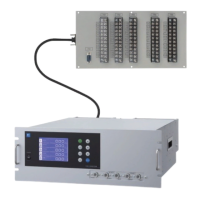6 - 26
Action of peak alarm
Example
Count
ON
123 4
1 2 3 4 times
5 times
Count
ON
Count
OFF
Peak concentration
Measured values
Peak count alarm
Count
OFF
Hysteresis
1 hour
1 hour
This peak is ignored because
the measured value has not
go down below the hysteresis
band after the first peak.
(1) The analyzer emits a peak count
alarm because the peak count has
reached five times per hour.
(2) The analyzer stops the peak
count alarm because the
peak count during the latest
hour was four.
,I&2FRQFHQWUDWLRQH[FHHGVWKHDODUPYDOXHFRXQWLQJZLOOEHJLQ,IWKHQXPEHURISHDNVLVRYHU
the set times per hour, a peak alarm contact output becomes closed (ON). If it is less than the set
times per hour, it is open (OFF). Since 5 times of peaks /hour is marked at (1) section from
the above graph, the peak count alarm is turned ON. Since peaks of more than 5 times per 1 hour
occur at the interval between (1) and (2) , the peak count alarm remains ON. Since at (2),
peaks are reduced to 4 times per hour, it is turned OFF.
/LNHWKHK\VWHUHVLVRIWKHDODUPVHWWLQJWKHK\VWHUHVLVSUHYHQWVSRVVLEOHFKDWWHULQJZKHQPHD-
VXUHGJDVLVÀXFWXDWHGQHDUWKHDODUPYDOXH
* For 10 minutes after the power is turned ON, a peak alarm counting is not carried out.
Releasing peak count alarm
To release the peak count alarm, set the peak alarm to OFF.
Turning on the peak alarm initiates counting from 0.
[% full scale] represents the percentage with the CO range regarded as 100%.
Setting range
Alarm value : 10 to 1000 ppm 5 ppm step (initial value: 500 ppm)
Alarm count : 1 to 99 times 5 ppm step (initial value: 5 times)
Hysteresis : 0 to 20 % of full scale 5 ppm step (initial value: 0% of full scale)
•
•
•
________
I
______________
_

